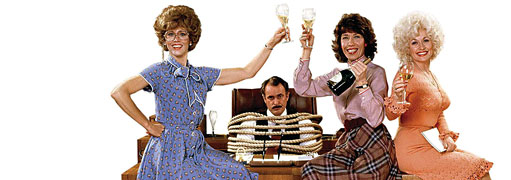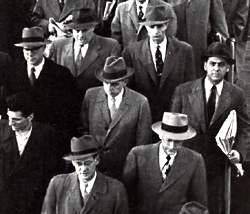As a kid, one of my favorite movies was the 1980 flick 9 to 5. Starring Lily Tomlin, Jane Fonda and Dolly Parton as three overworked and vastly underappreciated secretaries, it’s a revenge fantasy cloaked as a screwball comedy (entirely appropriate viewing for any 5-year-old).The plot: Harassed and belittled by their “sexist, egotistical, lying, hypocritical bigot” of a boss, played by professional mustache-twirler Dabney Coleman, the women stumble into keeping him prisoner inside his house, employing a complex system of pulleys and S&M gear in their mission. Free from his tyranny, they use the opportunity to make much-needed changes in the structure of their office—including onsite day care for the employees’ children, a job-sharing program allowing workers to modify their schedules and equal pay for equal work (though the men laugh about that last one). For everything I didn’t get about the movie at the time (sex gear, marijuana smoking, Dolly Parton’s nails), the spirit of the film resonated with me. Here were three women who were tired of being overlooked and mistreated simply because they had the audacity to be female, and even worse, women who worked. I knew from very early on in my life that I would work even if I had children. I remember thinking: It’s good that things are changing, so when I’m grown up, how women are treated in the workplace won’t even be an issue. This is the part where we all give each other sideways glances.It’s incredible—and embarrassing—that a 32-year-old movie portrays a work environment that’s far more hospitable to women than many today. Yes, we have come a long way, baby. Yes, women hold positions of great power. Yes, women are the majority of college graduates. Yes, we can wear either pants or skirts, creating just so many wardrobe options. These are all great accomplishments. Go us. But by now, you probably know the other side. Women on the whole are still paid less than men (and part of that gap has no discernible reason outside of bias). Traditionally female-dominated jobs, such as teaching and nursing, are grossly undervalued and undercompensated. The United States is one of only four nations in the world without any mandated paid maternity leave, leaving it in good company with Papua New Guinea, Swaziland and Liberia, despite the fact that women are only slightly less than 50 percent of the U.S. workforce. This is old news, though, so why continue to talk about it? Simply, because any changes have been incremental and usually followed by a few paces backwards. And unlike in 9 to 5 , where the mistreatment of female employees stems from the villainy of one slimy asspuck, gender bias is rarely due to the conscious efforts of one man. What makes any bias difficult to counter is that it is cultural, deep-seated and often unconscious. In the workplace, policies that are inhospitable to women stem from a mindset that idealizes a mythical figure I call “1950s Man.” So many of the practices we adhere to today have roots in postwar, corporate-boom America. This workforce was populated with 1950s Man, and the expectations and remuneration we still follow are designed for this creature. Does 1950s Man need a month off to help care for his newborn son? Hell, no. He’s got a wife who stays home full-time to do that kind of thing, and when she’s exhausted to the point of incapacitation, there are pills to lift her up. Does 1950s Man need time off to take care of a sick child? Damnit, man, did you not read the previous sentence? So, I guess 1950s Man definitely doesn’t need maternity leave to heal and establish nursing, right? Listen, son: 1950s Man doesn’t want to think about that kind of thing. He didn’t kill Nazis so you could talk about lady bits, consarnit. 1950s Man will work as late as you need and be happy with 10 days off a year because vacation is for those sissy surrendering French. He won’t eat up your pension fund because he’ll die at 58 of a massive coronary, never learning his oldest son is gay.Some say it was this kind of work environment that made America great, and by “some,” I mean anyone who isn’t female, nonwhite or poor. The rest of us can see that this approach to the modern worker is grossly outdated and penalizes women in the workforce for, well, being women while in the workforce. Our inability to be, as Henry Higgins says, “more like a man” has real costs to our salaries and our professional prospects. And you know who else isn’t 1950s Man? Men. Men today. Gender bias doesn’t just hurt women—it limits men as well. It consigns them to certain roles at work and at home. Few American men take any parental leave, and only 1 out of 100 take more than four weeks out of fear for their careers. As a society, we’re still conditioned to view men’s active participation in parenting as a great bonus—but not essential. This harms men, forcing them to increasingly make the same decision women have for years—career or family? You can do both, but it’s hard to do both well. Seeing 1950s Man as the default employee constrains the majority of workers today, who look nothing like that pomaded work machine. But before we continue addressing these complex issues, there’s one thing we should all agree on: Let’s stop using phrases like “entitlements,” “perks” and, worst of all, “special treatment” when discussing ideas to improve work-life balance. That’s like saying a salary is special treatment: Shouldn’t you people just be happy for the rags and gruel? None of us, men or women, cease to be whole people with a host of responsibilities just because we’re clocked in. Recognizing this leads to greater employee satisfaction, productivity and profit. Yes, 9 to 5 is just a movie, but it serves as an unsettling reminder of the inequality that we’ve accepted as the status quo. Could you look into the eyes of American treasure Dolly Parton and say you gave up the fight?
Erin Adair-Hodges teaches English at Central New Mexico Community College, where she chairs a committee that addresses issues related to work-life balance. She is a former arts and copy editor for the Alibi.
The opinions expressed are solely those of the author.






